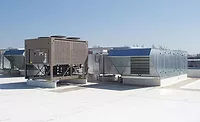How does air affect food safety in snack and bakery facilities?

Megan Coy
The air around your product should be maintained just like all equipment and product itself. The air intake system should be part of your sanitary design program, evaluating the design to ensure inspection and cleaning hatches are installed at various points for proper maintenance.
Air intake systems pull the air from the outside into the plant, along with many possible contaminants, such as dust, water, bacteria, chemicals, mold, insects, off odors and other chemical, physical and microbiological contaminants. If the outside air enters the facility untreated, it could contaminate your product. The air handling system should filter the air to provide a clean production environment.
Positive air pressure is a best practice for air within a facility. Air should flow from cooked or pasteurized areas to raw or uncooked areas. How do you know if your facility has positive air pressure? Open a door between two areas and see if you can feel the airflow. The air should be flowing out of your facility, or from low risk areas to high risk areas. You can also use devices that will monitor airflow in feet per minute from one room to the next. Without positive air pressure, the simple act of opening a door can allow outside air to enter the facility and potentially contaminate the product.
Testing air quality is critical. Microbiological testing for yeast and mold, and particle count testing, is recommended. Testing methods include air sedimentation plates and mechanical air samplers. Air sedimentation plates are standard petri dishes containing the culture media. The plate is exposed to the air for a predetermined amount of time. The plate is then incubated for five days and the results are reviewed for mold and yeast growth. Mechanical air sampling runs air through a device to test for microbiological contamination and/or particle count. The air is moved over or around a culture media plate, which is then incubated for five days. The results should show little to no yeast or mold to ensure the air is free of potential risks. There is no regulated limit for these counts, but you should establish your own limits.
Air handling units should have filters in place to remove particles of a defined size. The pre-filters on the air handling units should be minimally capable of removing airborne particulates of 50 microns in size or a minimum efficiency reporting value (MERV) of 4 or larger. The higher the number on the MERV rating, the smaller the particle size it can filter. If air is used for direct product contact, additional filtering should be put in place. Compressed air should be filtered to 5 microns or less. Replace filters at predetermined frequency to ensure proper operation. Air handling units outside, such as on the roof, might require changing more often based on seasonal changes or conditions, such as construction.
Air makeup systems and ductwork should be cleaned on a routine basis to prevent any dust, debris, moisture and other contaminates from accumulating. This accumulation could cause environmental concerns in production or other areas of the facility or, depending upon the type of product, mold or insect concerns. Vacuuming the units is a good first step. Additional cleaning could also include use of chemicals and sanitizers. Air plate monitoring activities will help determine the proper frequency. Inspection of the units should include functionality, cleanliness, filter placement and air monitoring, which is typically managed as part of the preventive maintenance program. Random verification of how well your program is working can be included as part of monthly self-inspections.
You also want to address the air leaving your facility, or the ventilation. A positive air system will send air out of your facility, with openings for the air to escape. Exhaust fans are common ventilation units. These openings should seal when the fans are not in operation. Other ventilation areas should be screened to allow air to escape, but not allow anything into the facility.
Areas storing hazardous chemicals should be properly ventilated to prevent hazardous fumes from reaching personnel or product. Restroom ventilation is also critical. Negative air pressure should be in place in restrooms. The air should flow into the restroom and be vented out of the building. This will help control odor and microbiological issues. Restroom doors also should not open directly into production, packaging or storage areas.
Looking for quick answers on food safety topics?
Try Ask FSM, our new smart AI search tool.
Ask FSM →







